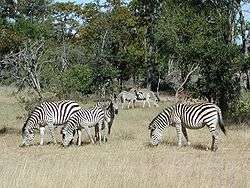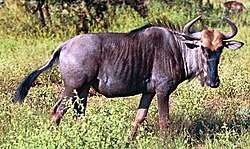Wildlife of Angola
The wildlife of Angola is composed of its flora and fauna.




An Atlas of the Amphibians and Reptiles of Angola, was published in 2018, and report 117 species of amphibians and 278 of reptiles [1]
A major book on the Biodiversity of Angola was published in 2019, and report more than 2000 species of organisms (plants, invertebrates and vertebrate animals)[2], and 1313 fossil species [3]
Fauna
Mammals
Birds
The avifauna of Angola includes a total of 983 species, of which 14 are endemic, 1 has been introduced by humans, and 4 are rare or accidental. 20 species are globally threatened.
The western Angola Endemic Bird Area has 14 range-restricted species. Little is known about the conservation status of the region's birds due to the civil war that has raged in Angola for the last 27 years. The greatest diversity of restricted-range species is found in Cuanza Sul province, and given the uncertainty about their current status, many of these species are listed as Threatened. Gabela Bush-shrike Laniarius amboimensis are common and Monteiro's Bush-shrike Malaconotus monteiri are fairly common in degraded secondary forest, old coffee plantations and primary forest at Kumbira. Pulitzer's Longbill Macrosphenus pulitzeri is fairly common at higher elevations at Kumbira as well as in the dense understorey of secondary forest west of Seles. Angola Cave-chat Xenocopsychus ansorgei is found on the rocky slopes above the forest at Kumbira.
Insects
Fish
Reptiles
Currently 278 species are recorded for the country [4]
Amphibians
Currently 117 species are recorded for the country [5]
Flora
The southern and central coasts include the welwitschia, a primitive conifer. The grassy savanna around Lobito includes baobab and euphorbia trees.[6]
The Huambo, Benguela and Huíla provinces are home to montane forest with rare flora.
The grassy savanna in the north includes miombo woodland and some evergreen forest.
Notes
- Marques, Mariana P.; Ceríaco, Luis M. P.; Blackburn, David C.; Bauer, Aaron M. (2018). "Diversity and Distribution of the Amphibians and Terrestrial Reptiles of Angola: Atlas of Historical and Bibliographic Records (1840-2017)" (PDF). Proceedings of the California Academy of Sciences. Suplemento II. 65: 1–501. ISSN 0068-547X.
- BIODIVERSITY OF ANGOLA : science & conservation. SPRINGER. 2019-02-09. ISBN 978-3-030-03082-7.
- Mateus, Octavio; Callapez, Pedro; Polcyn, M.; Schulp, A.; Gonçalves, A.; Jacobs, L. (2019). The Fossil Record of Biodiversity in Angola Through Time: A Paleontological Perspective. Springer.
- Marques, Mariana P.; Ceríaco, Luis M. P.; Blackburn, David C.; Bauer, Aaron M. (2018). "Diversity and Distribution of the Amphibians and Terrestrial Reptiles of Angola: Atlas of Historical and Bibliographic Records (1840-2017)" (PDF). Proceedings of the California Academy of Sciences. Suplemento II. 65: 1–501. ISSN 0068-547X.
- Marques, Mariana P.; Ceríaco, Luis M. P.; Blackburn, David C.; Bauer, Aaron M. (2018). "Diversity and Distribution of the Amphibians and Terrestrial Reptiles of Angola: Atlas of Historical and Bibliographic Records (1840-2017)" (PDF). Proceedings of the California Academy of Sciences. Suplemento II. 65: 1–501. ISSN 0068-547X.
- National Audubon Society (2009). Field Guide to African Wildlife. New York: Alfred A. Knopf. pp. 44–46. ISBN 978-0-679-43234-0.
References
- Wilson, Don E.; Reeder, DeeAnn M., eds. (2005). Mammal Species of the World: A Taxonomic and Geographic Reference (3rd ed). Johns Hopkins University Press. Retrieved 3 August 2009.
- "Animal Diversity Web". University of Michigan Museum of Zoology. 1995–2006. Retrieved 22 May 2007.